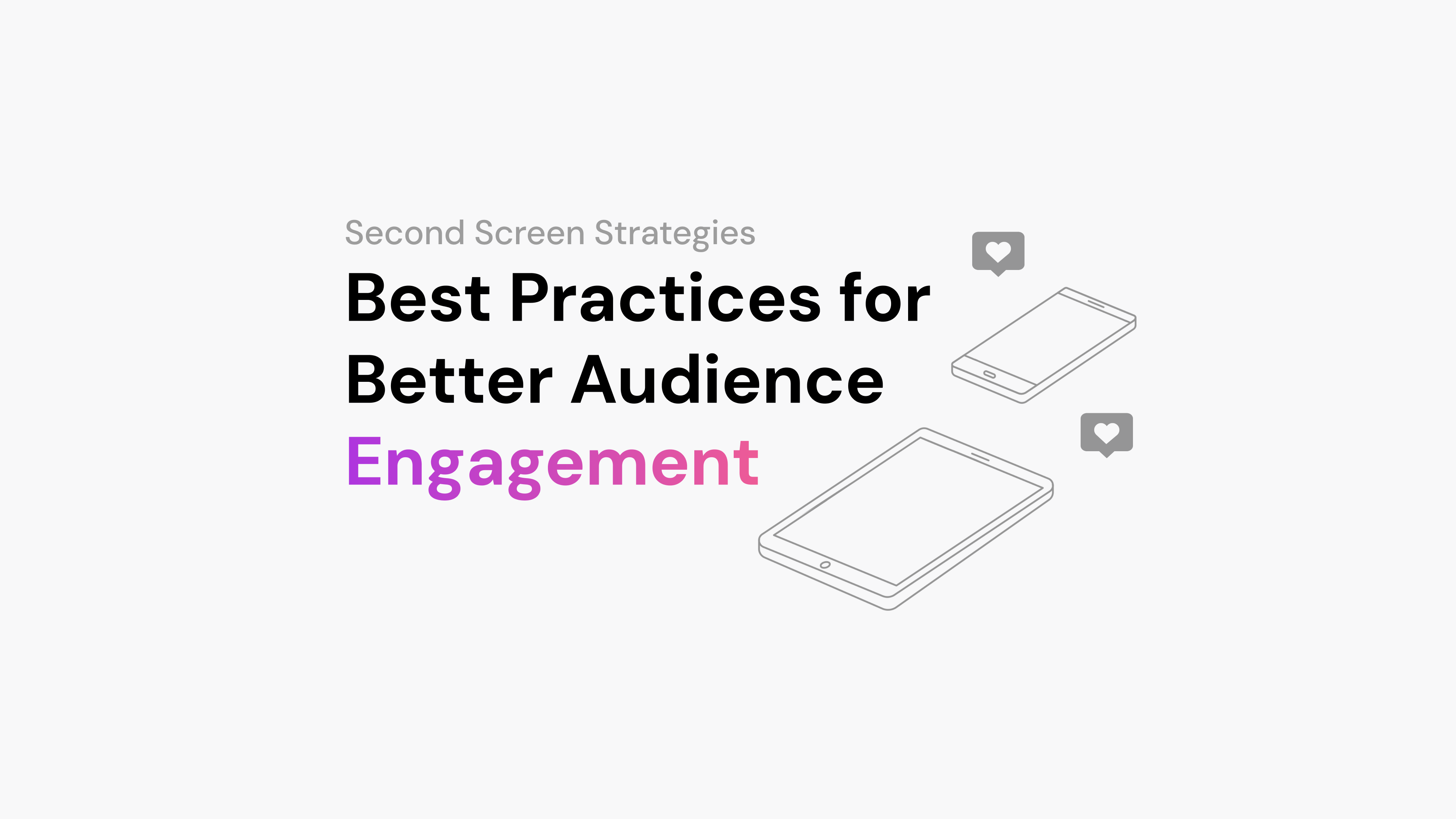Audiences today aren’t just watching—they’re engaging across multiple devices at the same time. For professionals in media, entertainment, sports, and e-commerce, harnessing second screen trends is key to capturing and holding audience attention. Embracing these trends can help businesses boost user interaction, create more compelling experiences, and strengthen community connections within their own digital spaces.
In brief:
- Second screen trends are transforming how audiences engage with media across multiple devices.
- Businesses can enhance user interaction and build community by embracing these trends.
- Developing proprietary second screen platforms allows for personalized experiences and valuable insights through data analytics.
- Investing in second screen strategies can drive growth and increase engagement in media, entertainment, sports, and e-commerce sectors.
Types of Second Screen Strategies Use Cases
Second screen technology offers new ways to interact with media content, leading to innovative second-screen experiences. One common use is engaging with social media while watching TV. For example:
- 71% of users access social media during shows, enhancing the viewing experience with real-time discussions and reactions.
- Platforms like Twitter become places for live-tweeting, letting viewers talk about plot twists or game highlights as they happen.
E-commerce is also expanding on second screens:
- With 35% of viewers shopping online while watching TV, commerce and entertainment are merging.
- Whether responding to a “buy now” prompt or exploring products from a show, the second screen offers a convenient way to shop, creating a personalized e-commerce experience.
- This dual engagement enhances the consumer experience and provides brands with a platform to attract customers and increase sales.
Benefits of Second Screen Engagement
Second screen technology can significantly improve audience engagement, enabling real-time interactions and discussions. To understand how second screen technology transforms businesses, let’s explore some key benefits.
Enhance Audience Engagement
Second screens allow for personalized content delivery, enhancing reader engagement. Adding game-like elements and customizing recommendations can make the experience more engaging. For example, offering exclusive content can captivate viewers, encouraging them to engage more and build a stronger connection with your audience. Learn more.
Facilitate Real-Time Interaction and Discussions
Second screens enable real-time interactions with a real-time audience. Over 70% of adults use second screens while watching TV. Integrating live polls, quizzes, and discussions into your content strategy can enhance engagement. Social media platforms become extensions of the viewing experience, allowing instant feedback and participation, creating a community around your content and maintaining interest. Find out more
Using these approaches can help you make the most of second screen technology to enhance your audience’s experience. For more in-depth strategies, check out this guide to audience engagement.
How Second Screens Fuel Interactive Advertising
Second screens are changing how advertisers engage viewers in real-time. Synchronizing ads across TV and mobile allows brands to create consistent experiences. Imagine watching a commercial on TV while receiving a related ad on your smartphone. This strengthens brand messaging and encourages immediate interaction. According to Inc.com, over 62% of Americans browse the internet while watching TV, providing an opportunity for marketers.
Second screens also provide extra content and exclusive access. Viewers can find more details, like character backstories or interviews, through apps or websites. For news outlets, using a live blog for news coverage provides timely updates and enhances audience engagement through real-time information and interactive features. This adds depth to the storytelling and strengthens the connection with the audience. For example, Digital Trends shows how exclusive content can expand the story beyond the main screen.
Using these methods, brands can attract attention, increase engagement, and build brand loyalty. Integrating second screens into advertising offers a chance to create engaging, multi-platform experiences.
Common Second Screen Habits in Usage
In 2024, second screen usage is widespread, changing how people interact with media. Understanding the strategy stats and trends for 2025 can help businesses prepare for future developments. Smartphones are the main device for this dual engagement, used by 51% of second screeners, according to You.com and Business2Community.
Generation Z’s use of second screens is significant. They often use smartphones with other devices, interacting with music programs and series. Their ease with technology and multitasking shows as they switch between content and social media. 71% engage with social media on smartphones while watching TV, and 35% shop online, showing high engagement, according to Go-Globe.
These trends show that marketers and content creators should adjust their strategies to match changing behaviors, especially among audiences like Generation Z.
How to Develop Proprietary Second Screen Platforms
Developing your own second screen platforms allows you to customize experiences for your industry’s needs and manage user engagement. Considering the differences between a community platform vs social media can help you decide the best approach for engaging your audience. This approach improves interaction and gives you an advantage by creating platforms that suit your audience.
1. Build Platforms for Specific Industries
Design platforms that match the trends and expectations of your industry. In entertainment, platforms can offer interactive stories or exclusive content, adding to the experience. Sports organizations can include features like real-time statistics and multi-angle viewing, making viewers more involved. Implementing a second screen in sports strategy allows fans to engage more deeply with content. Focusing on your industry’s unique aspects helps create platforms that appeal to your audience and keep them engaged.
2. Use Data Analytics from Interactions
Data analytics help personalize the second screen experience. Analyzing interactions reveals habits and preferences, allowing you to tailor content recommendations and improve satisfaction. Platforms can use data to deliver personalized ads or suggest content that matches viewer interests, increasing engagement and keeping users on the platform longer. Effective data collection for the sports industry enables the development of features that truly resonate with fans, enhancing engagement. Good analytics let you adjust the experience and make informed decisions, helping the platform evolve with user needs.
Creating your own platforms and applying analytics helps you build engaging experiences that increase user involvement and grow your community.
Strategies for Engaging Sports Fans Through Second Screens
With 86% of internet users using a second device while watching TV, it’s important to use this trend effectively. Learn more
Enhance Sports Fan Engagement with Features
To engage sports fans digitally, include features that enhance their experience. Provide real-time statistics and player information through companion apps, giving viewers more insights. Integrating fantasy sports lets fans actively participate by managing teams and tracking performances in real time. Effective data collection for the sports industry enables the development of features that truly resonate with fans, enhancing engagement.
Provide Real-Time Updates and Live Interactions
Real-time updates are important for sports second screen strategies. Features like live betting options and team-specific chat rooms increase fan interaction. These environments build community among fans, involving them beyond just watching. By fostering engagement through these features, organizations can effectively monetize sports communities, turning fan involvement into revenue. Adding game elements, like trivia games about matches, keeps fans engaged.
These strategies enable sports organizations to create engaging experiences that keep fans involved and build communities. Arena’s AI-driven tools can engage fans through features like polls, quizzes, and comment sections, transforming them from passive viewers into active participants.
Is Investing in Second Screen Strategies Worth It?
With 88% of Americans using a second screen while watching TV, businesses can reach audiences in new ways.
Assess Return on Investment for Businesses
Investing in second screen technology can provide good returns by improving engagement and enabling real-time interactions. Second screens allow for synchronized advertising, attracting attention even during commercial breaks, and linking TV content with mobile experiences. Brands can deliver personalized content, boosting loyalty and increasing sales.
Drive Growth and Engagement Potential
Beyond immediate returns, second screens are useful for long-term growth. They help build communities through interactive experiences that encourage participation, like live polls or discussions. Data from these interactions helps create personalized experiences, strengthening your digital presence and brand loyalty. As more companies recognize the value, investing in second screens becomes essential for growth in the digital landscape.
Embrace the Future of Engagement with Second Screen Strategies
As second screen usage rises, there’s great potential for creating interactive experiences. Understanding the latest trends helps digital marketing, content, and community managers improve engagement, enable real-time interactions, and promote growth across media, entertainment, sports, and e-commerce platforms. Ready to see how an effective brand community can impact your bottom line?
Sign up now at Arena and start using our features to boost engagement and retention. Join the many brands that trust Arena to turn visitors into loyal customers.



